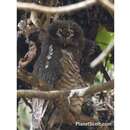Biology
provided by Arkive
This strictly nocturnal species roosts during the day in dense vegetation, 1 to 30 metres off the ground, either alone or in pairs (2). At night, it emerges to hunt for arthropods, reptiles, small mammals and birds, which are caught on the wing, off the ground or in trees and shrubs (2) (6).
The nests are generally made in tree holes, without additional lining material. Between one and three eggs are laid, at two to four day intervals, and incubated by the female for around 31 days. During this time, the male does all the hunting and feeds the female at the nest. The hatchlings open their eyes after about ten days and start branching after 23 to 37 days. By around 45 days after hatching, the young will be competent fliers but remain with the parents until roughly four months old (5).
Conservation
provided by Arkive
There are no known conservation measures currently in place for the African wood-owl.
Description
provided by Arkive
The African wood-owl is a medium sized owl distinguished by the notable lack of ear tufts on its rounded head, large dark eyes outlined by white eyebrows, and brown and white barred belly (2) (4). Overall, it has rich brown plumage with paler underparts, but there is considerable variation in shade and patterning across its range (2). Four subspecies that differ slightly in appearance and size are sometimes recognised: Strix woodfordii woodfordii, S.w.umbrina, S.w.nigricantior, S.w.nuchalis (2) (5) (6). The male call is a rapid series of clear hoots, which the female typically answers in a higher pitched, but more leisurely tone (5).
Habitat
provided by Arkive
The African wood-owl is the commonest owl in woodland and forests throughout Africa. It occurs in deep woodland, forests edges, riverine and coastal forests, and plantations (2) (4) (5).
Range
provided by Arkive
The African wood-owl occurs from Senegal to Ethiopia and south to Angola, Botswana, Mozambique, and the south and east coast of South Africa (5) (6).
Status
provided by Arkive
Classified as Least Concern (LC) on the IUCN Red List (1) and listed on Appendix II of CITES (3).
Threats
provided by Arkive
As the African wood-owl is completely dependent on forest and woodland habitat, it is very susceptible to deforestation. Nonetheless, it is still described as common and its population is thought to be stable. Consequently it is classified as Least Concern on the IUCN Red List (1) (7).

